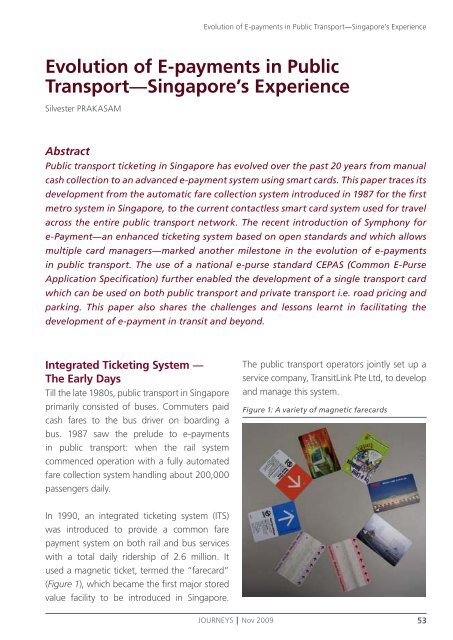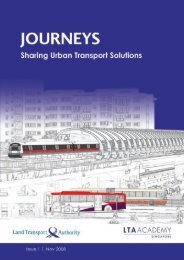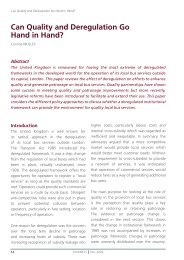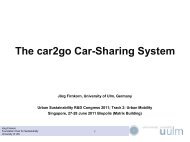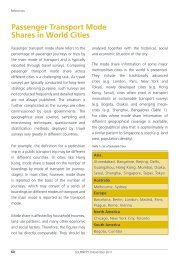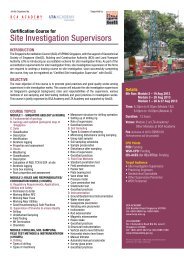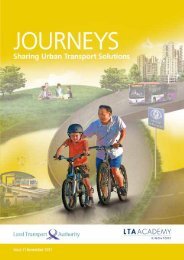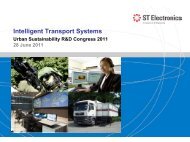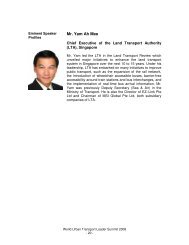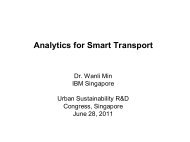Evolution of E-payments in Public Transport—Singapore's ... - IBM
Evolution of E-payments in Public Transport—Singapore's ... - IBM
Evolution of E-payments in Public Transport—Singapore's ... - IBM
Create successful ePaper yourself
Turn your PDF publications into a flip-book with our unique Google optimized e-Paper software.
<strong>Evolution</strong> <strong>of</strong> E-<strong>payments</strong> <strong>in</strong> <strong>Public</strong><br />
Transport—S<strong>in</strong>gapore’s Experience<br />
Silvester PRAKASAM<br />
Abstract<br />
<strong>Public</strong> transport ticket<strong>in</strong>g <strong>in</strong> S<strong>in</strong>gapore has evolved over the past 20 years from manual<br />
cash collection to an advanced e-payment system us<strong>in</strong>g smart cards. This paper traces its<br />
development from the automatic fare collection system <strong>in</strong>troduced <strong>in</strong> 1987 for the first<br />
metro system <strong>in</strong> S<strong>in</strong>gapore, to the current contactless smart card system used for travel<br />
across the entire public transport network. The recent <strong>in</strong>troduction <strong>of</strong> Symphony for<br />
e-Payment—an enhanced ticket<strong>in</strong>g system based on open standards and which allows<br />
multiple card managers—marked another milestone <strong>in</strong> the evolution <strong>of</strong> e-<strong>payments</strong><br />
<strong>in</strong> public transport. The use <strong>of</strong> a national e-purse standard CEPAS (Common E-Purse<br />
Application Specification) further enabled the development <strong>of</strong> a s<strong>in</strong>gle transport card<br />
which can be used on both public transport and private transport i.e. road pric<strong>in</strong>g and<br />
park<strong>in</strong>g. This paper also shares the challenges and lessons learnt <strong>in</strong> facilitat<strong>in</strong>g the<br />
development <strong>of</strong> e-payment <strong>in</strong> transit and beyond.<br />
Integrated Ticket<strong>in</strong>g System —<br />
The Early Days<br />
Till the late 1980s, public transport <strong>in</strong> S<strong>in</strong>gapore<br />
primarily consisted <strong>of</strong> buses. Commuters paid<br />
cash fares to the bus driver on board<strong>in</strong>g a<br />
bus. 1987 saw the prelude to e-<strong>payments</strong><br />
<strong>in</strong> public transport: when the rail system<br />
commenced operation with a fully automated<br />
fare collection system handl<strong>in</strong>g about 200,000<br />
passengers daily.<br />
In 1990, an <strong>in</strong>tegrated ticket<strong>in</strong>g system (ITS)<br />
was <strong>in</strong>troduced to provide a common fare<br />
payment system on both rail and bus services<br />
with a total daily ridership <strong>of</strong> 2.6 million. It<br />
used a magnetic ticket, termed the “farecard”<br />
(Figure 1), which became the first major stored<br />
value facility to be <strong>in</strong>troduced <strong>in</strong> S<strong>in</strong>gapore.<br />
<strong>Evolution</strong> <strong>of</strong> E-<strong>payments</strong> <strong>in</strong> <strong>Public</strong> Transport—S<strong>in</strong>gapore’s Experience<br />
The public transport operators jo<strong>in</strong>tly set up a<br />
service company, TransitL<strong>in</strong>k Pte Ltd, to develop<br />
and manage this system.<br />
Figure 1: A variety <strong>of</strong> magnetic farecards<br />
JOURNEYS Nov 2009 53
<strong>Evolution</strong> <strong>of</strong> E-<strong>payments</strong> <strong>in</strong> <strong>Public</strong> Transport—S<strong>in</strong>gapore’s Experience<br />
For buses, the payment system under ITS<br />
rema<strong>in</strong>ed largely manual. The commuter would<br />
<strong>in</strong>sert his farecard <strong>in</strong>to a bus validator (Figure 2)<br />
and choose the appropriate fare, after which<br />
his farecard would be returned together with a<br />
ticket for his ride.<br />
Figure 2: A bus validator<br />
Initially, the farecards could only be topped-up<br />
us<strong>in</strong>g cash at TransitL<strong>in</strong>k <strong>of</strong>fices <strong>in</strong> rail stations.<br />
This top-up service was later extended to<br />
bus <strong>in</strong>terchanges. Self-service mach<strong>in</strong>es were<br />
subsequently <strong>in</strong>troduced to allow top-up<br />
through EFTPOS (Electronic Fund Transfer at<br />
Po<strong>in</strong>t <strong>of</strong> Sale).<br />
The convenience <strong>of</strong> the farecard, compared to<br />
the hassle <strong>of</strong> carry<strong>in</strong>g sufficient cash, drove a<br />
progressive conversion to farecards. By the<br />
late 1990s, farecards were used for 85% <strong>of</strong><br />
public transport trips. The reduction <strong>in</strong> cash<br />
management translated to a significant sav<strong>in</strong>g<br />
<strong>of</strong> about 7% <strong>in</strong> operat<strong>in</strong>g costs for the public<br />
transport operators.<br />
54<br />
JOURNEYS Nov 2009<br />
Introduc<strong>in</strong>g Contactless<br />
Smart Cards<br />
Contactless smart cards made their appearance<br />
<strong>in</strong> public transport <strong>in</strong> Europe and Japan <strong>in</strong><br />
the early 1990s. Due to the need to enhance<br />
S<strong>in</strong>gapore’s ticket<strong>in</strong>g system, the Land<br />
Transport Autority (LTA) undertook several<br />
years <strong>of</strong> studies and field trials and decided<br />
to use the contactless smart card as the new<br />
ticket medium even though the underly<strong>in</strong>g<br />
technology, <strong>in</strong>clud<strong>in</strong>g the card itself, was largely<br />
proprietary.<br />
In 2002, after three years <strong>of</strong> development, LTA<br />
rolled out the Enhanced Integrated Fare System<br />
(EIFS). The new system used contactless smart<br />
cards, known as ez-l<strong>in</strong>k cards, to replace the<br />
magnetic farecards. Figure 3 shows a commuter<br />
tapp<strong>in</strong>g the contactless ez-l<strong>in</strong>k card aga<strong>in</strong>st the<br />
reader at a fare gate.<br />
Figure 3: An ez-l<strong>in</strong>k card be<strong>in</strong>g used at a rail station<br />
Enhancements under EIFS<br />
EIFS <strong>of</strong>fered several enhancements over the ITS:<br />
(i) 1¢ <strong>in</strong>crements <strong>in</strong>stead <strong>of</strong> 5¢ <strong>in</strong>crements, to<br />
provide greater flexibility for fare sett<strong>in</strong>g<br />
and adjustments;<br />
(ii) An extended fare structure compared to<br />
the magnetic card. This enhancement was<br />
necessary for the ticket<strong>in</strong>g system to cater<br />
to an expanded rail network;
(iii) The extended fare structure allowed<br />
commuters to transfer between different<br />
transit networks (separate operators)<br />
without hav<strong>in</strong>g to exit and re-enter. Fares<br />
were apportioned between the operators<br />
<strong>in</strong> the backend system on a daily basis<br />
based on an agreed formula. This capability<br />
made transfers easier for commuters and<br />
prevented unnecessary hardware costs as<br />
there was no need for additional fare gates<br />
between transit networks.<br />
(iv) The transfer fare rebate1 could be<br />
apportioned <strong>in</strong> absolute or percentage terms<br />
to allow a fairer revenue apportionment<br />
among the operators;<br />
(v) More detailed and accurate analysis <strong>of</strong><br />
data could be done <strong>in</strong> one-m<strong>in</strong>ute <strong>in</strong>tervals<br />
<strong>in</strong>stead <strong>of</strong> 15 m<strong>in</strong>utes; and<br />
(vi) Up to 15 public transport operators could<br />
be accommodated by the system.<br />
In addition, EIFS undertook a major process<br />
and system re-eng<strong>in</strong>eer<strong>in</strong>g by hav<strong>in</strong>g entry/exit<br />
process<strong>in</strong>g on buses.<br />
Bus commuters have to present their ez-l<strong>in</strong>k<br />
cards at the entry and exit processors (Figure<br />
4) which will capture <strong>in</strong>formation for fare<br />
calculation, e.g., bus service number, direction,<br />
entry and exit fare stages. At the entry processor,<br />
the maximum fare for the rema<strong>in</strong><strong>in</strong>g trip on the<br />
Figure 4: A bus entry processor and a commuter<br />
tapp<strong>in</strong>g her card upon board<strong>in</strong>g a bus<br />
<strong>Evolution</strong> <strong>of</strong> E-<strong>payments</strong> <strong>in</strong> <strong>Public</strong> Transport—S<strong>in</strong>gapore’s Experience<br />
bus will be deducted from the card. At the exit<br />
processor, the actual fare will be calculated and<br />
unused fare refunded.<br />
With this automatic calculation <strong>of</strong> fares, bus<br />
commuters were spared the hassle <strong>of</strong> enquir<strong>in</strong>g<br />
and calculat<strong>in</strong>g the fares payable and bus drivers<br />
could focus on driv<strong>in</strong>g. The entry/exit process<strong>in</strong>g<br />
also resulted <strong>in</strong> a significant reduction <strong>in</strong> fare<br />
leakage for bus operators, estimated to be <strong>in</strong><br />
the region <strong>of</strong> $35m annually.<br />
Ensur<strong>in</strong>g smooth transition from<br />
ITS to EIFS<br />
The EIFS replaced the magnetic farecard<br />
system with<strong>in</strong> 9 months, helped by a<br />
comprehensive communications strategy that<br />
achieved buy-<strong>in</strong> from various stakeholders<br />
and ensured a smooth and successful<br />
implementation <strong>of</strong> the new ticket<strong>in</strong>g system.<br />
Some measures <strong>in</strong>cluded:<br />
(i) The government showed strong<br />
commitment by provid<strong>in</strong>g significant<br />
fund<strong>in</strong>g for the upfront cost <strong>of</strong><br />
develop<strong>in</strong>g the system. This <strong>in</strong> turn<br />
helped to secure support from the public<br />
transport operators;<br />
(ii) As students formed 18% <strong>of</strong> the commut<strong>in</strong>g<br />
public, LTA worked with TransitL<strong>in</strong>k and<br />
the M<strong>in</strong>istry <strong>of</strong> Education to provide<br />
personalised concession travel passes,<br />
which also served as student identity cards.<br />
This arrangement reduced the abuse <strong>of</strong><br />
concession privileges;<br />
(iii) Prior to full roll-out <strong>of</strong> the system, a group<br />
<strong>of</strong> regular commuters was <strong>in</strong>vited to use<br />
the cards. This served the dual objectives<br />
<strong>of</strong>: 1) educat<strong>in</strong>g this group so they would <strong>in</strong><br />
turn be ambassadors to other commuters<br />
JOURNEYS Nov 2009 55
<strong>Evolution</strong> <strong>of</strong> E-<strong>payments</strong> <strong>in</strong> <strong>Public</strong> Transport—S<strong>in</strong>gapore’s Experience<br />
after full system roll out; and 2) generat<strong>in</strong>g<br />
a critical mass <strong>of</strong> 1 million transactions to<br />
stress test the system; and<br />
(iv) Extensive publicity and public education<br />
programmes ran on various channels,<br />
such as TV, pr<strong>in</strong>t media, roadshows,<br />
posters and communication sessions<br />
with grassroots leaders to educate the<br />
public on us<strong>in</strong>g the new system. Among<br />
the materials developed was a public<br />
education video entitled “Tap & Go.” The<br />
phrase soon caught on with the public<br />
and became a “tagl<strong>in</strong>e” <strong>in</strong> various public<br />
education efforts.<br />
Benefits <strong>of</strong> EIFS<br />
Faster commuter throughput for<br />
buses and tra<strong>in</strong>s<br />
The automatic fare calculation under EIFS<br />
enabled commuters to board buses more<br />
quickly, which shortened the dwell time <strong>of</strong><br />
buses at bus stops. Commuter throughput at<br />
the tra<strong>in</strong> stations also doubled, significantly<br />
reduc<strong>in</strong>g congestion <strong>in</strong> the busier stations<br />
dur<strong>in</strong>g peak periods. These improve the overall<br />
efficiency <strong>of</strong> public transport services.<br />
Enhanced data m<strong>in</strong><strong>in</strong>g capability<br />
for strategic plann<strong>in</strong>g<br />
LTA established an EIFS Data Warehouse to<br />
capture the large volume <strong>of</strong> transactions and<br />
enable automatic extraction <strong>of</strong> data from the<br />
backend system. This replaced manual surveys<br />
<strong>of</strong> bus commuters. The data warehouse has<br />
s<strong>in</strong>ce become a valuable resource for LTA <strong>in</strong><br />
its strategic plann<strong>in</strong>g, route plann<strong>in</strong>g for rail<br />
and bus services, and sett<strong>in</strong>g key performance<br />
<strong>in</strong>dicators for public transport services. For<br />
example, through data collected from EIFS,<br />
LTA can monitor the travel time commuters<br />
56<br />
JOURNEYS Nov 2009<br />
spend on public transport and develop<br />
<strong>in</strong>itiatives for improvement.<br />
Lower ma<strong>in</strong>tenance costs<br />
F<strong>in</strong>ally, contactless smart cards are more<br />
reliable and durable than magnetic farecards,<br />
with a failure rate <strong>of</strong> 1 <strong>in</strong> 25,000 transactions<br />
compared to 1 <strong>in</strong> 5,000 transactions for<br />
magnetic farecards. This means commuters<br />
spend less time replac<strong>in</strong>g faulty cards. The<br />
operators also benefit from a substantial<br />
reduction <strong>in</strong> equipment ma<strong>in</strong>tenance and<br />
operat<strong>in</strong>g costs, from 9% to 5% <strong>of</strong> capital<br />
cost, which is low by <strong>in</strong>dustry standards.<br />
Develop<strong>in</strong>g a New Generation <strong>of</strong><br />
Ticket<strong>in</strong>g System<br />
EIFS, like ITS, was built around the s<strong>in</strong>gle<br />
issuer-s<strong>in</strong>gle acquirer model. This restricted<br />
the choice <strong>of</strong> cards for both the commuters<br />
and service providers.<br />
Besides the ez-l<strong>in</strong>k card, the other stored value<br />
card widely used <strong>in</strong> S<strong>in</strong>gapore is the Cashcard.<br />
This is a contact card issued by NETS 2 . It is<br />
used for the payment <strong>of</strong> road pric<strong>in</strong>g charges<br />
and park<strong>in</strong>g at many car parks.<br />
The lack <strong>of</strong> <strong>in</strong>teroperability between the two<br />
systems precludes the shar<strong>in</strong>g <strong>of</strong> <strong>in</strong>frastructure.<br />
For <strong>in</strong>stance, the ticket<strong>in</strong>g system has to bear<br />
the high cost <strong>of</strong> <strong>in</strong>stall<strong>in</strong>g and support<strong>in</strong>g an<br />
add-value system <strong>in</strong>stead <strong>of</strong> leverag<strong>in</strong>g on<br />
what has been deployed by the bank<strong>in</strong>g sector<br />
for the Cashcard.<br />
In l<strong>in</strong>e with S<strong>in</strong>gapore’s vision for a cashless<br />
society and to br<strong>in</strong>g greater convenience to the<br />
general public, there was a need to move away<br />
from proprietary systems and cards towards
an environment where there are multiple card<br />
managers whose cards can be used anywhere<br />
anytime. To achieve this, it was necessary to<br />
develop standards to allow cards which are<br />
<strong>in</strong>teroperable across various systems.<br />
In l<strong>in</strong>e with S<strong>in</strong>gapore’s vision for a<br />
cashless society and to br<strong>in</strong>g greater<br />
convenience to the general public<br />
… need to move … towards …<br />
multiple card managers whose cards<br />
can be used anywhere anytime.<br />
The confluence <strong>of</strong> bus<strong>in</strong>ess needs and<br />
availability <strong>of</strong> suitable technology provided the<br />
impetus for LTA to develop a new ticket<strong>in</strong>g<br />
system <strong>in</strong>house based on open standards.<br />
Contactless e-Purse Application<br />
Specification (CEPAS)<br />
By 2004, the security and performance <strong>of</strong><br />
cards and readers had improved significantly.<br />
This <strong>in</strong> turn facilitated a more flexible bus<strong>in</strong>ess<br />
model for e-payment. The Government set up<br />
a taskforce compris<strong>in</strong>g representatives from<br />
several government agencies and the smart<br />
card <strong>in</strong>dustry to develop a national e-purse<br />
standard. The objectives were to:<br />
(i) Br<strong>in</strong>g together multiple payment<br />
applications onto a s<strong>in</strong>gle smart card;<br />
(ii) Enable greater synergy between<br />
applications and consequently less<br />
duplication <strong>of</strong> development resources and<br />
<strong>in</strong>frastructure; and<br />
(iii) Permit multiple entities participat<strong>in</strong>g <strong>in</strong><br />
a common e-payment scheme to create<br />
their own keys on a card that would be<br />
used to protect their own liabilities without<br />
affect<strong>in</strong>g the liabilities <strong>of</strong> other parties. This<br />
<strong>Evolution</strong> <strong>of</strong> E-<strong>payments</strong> <strong>in</strong> <strong>Public</strong> Transport—S<strong>in</strong>gapore’s Experience<br />
is analogous to each tenant <strong>of</strong> a build<strong>in</strong>g<br />
hav<strong>in</strong>g secure and <strong>in</strong>dependent access to<br />
their specific units without be<strong>in</strong>g seen by<br />
others, <strong>in</strong>clud<strong>in</strong>g the landlord.<br />
The Contactless e-Purse Application<br />
Specification (CEPAS) was released <strong>in</strong> 2nd quarter 2006 as the National e-Purse Standard<br />
SS518. It <strong>in</strong>corporated the requirements <strong>of</strong><br />
a bank<strong>in</strong>g e-purse as well as that for transit<br />
ticket<strong>in</strong>g and road pric<strong>in</strong>g, among other<br />
applications. (See box on Features <strong>of</strong> CEPAS).<br />
CEPAS <strong>in</strong> Transit Ticket<strong>in</strong>g—<br />
Symphony for e-Payment (SeP)<br />
Symphony for e-Payment (SeP) is the backend<br />
process<strong>in</strong>g, security and clear<strong>in</strong>g system<br />
developed by LTA for transit and non-transit<br />
<strong>payments</strong> to support CEPAS. It was developed<br />
entirely <strong>in</strong>house us<strong>in</strong>g open standards. This<br />
gives LTA greater flexibility to modify and<br />
enhance the system <strong>in</strong> future to meet evolv<strong>in</strong>g<br />
ticket<strong>in</strong>g needs without the constra<strong>in</strong>ts from<br />
use <strong>of</strong> proprietary s<strong>of</strong>tware. As SeP is built on<br />
open standards, card managers will have a<br />
wider choice <strong>of</strong> card suppliers while the public<br />
will benefit from a wider choice <strong>of</strong> cards.<br />
SeP also significantly reduces the technical<br />
entry barrier to new card managers for transit<br />
ticket<strong>in</strong>g as new bus<strong>in</strong>ess rules and operational<br />
procedures for handl<strong>in</strong>g cards from different<br />
managers have been established.<br />
Given that SeP can support multiple card<br />
managers, it is important to give the<br />
stakeholders a greater assurance on the<br />
accuracy <strong>of</strong> f<strong>in</strong>ancial reports generated by the<br />
system. Hence a well established account<strong>in</strong>g<br />
firm was engaged to design the f<strong>in</strong>ancial<br />
reports to meet best account<strong>in</strong>g practices.<br />
JOURNEYS Nov 2009 57
<strong>Evolution</strong> <strong>of</strong> E-<strong>payments</strong> <strong>in</strong> <strong>Public</strong> Transport—S<strong>in</strong>gapore’s Experience<br />
Features <strong>of</strong> CEPAS<br />
Several unique features were <strong>in</strong>corporated<br />
<strong>in</strong> CEPAS to provide the reliability and<br />
performance required for deployment <strong>in</strong> a<br />
myriad <strong>of</strong> applications. These <strong>in</strong>cluded:<br />
(i) Atomicity, i.e. no corrupted or partial<br />
updates to the card <strong>in</strong> contactless usage to<br />
ensure that <strong>in</strong>formation, when written on<br />
to a card, is always complete;<br />
(ii) AutoLoad to <strong>in</strong>crease purse balance by a<br />
specified amount when the debit amount<br />
is greater than purse balance, provided the<br />
This is <strong>in</strong> contrast to the traditional approach<br />
<strong>of</strong> engag<strong>in</strong>g an account<strong>in</strong>g firm to audit the<br />
system after its completion.<br />
On 1 October 2009, SeP replaced EIFS for<br />
transit ticket<strong>in</strong>g.<br />
CEPAS <strong>in</strong> Electronic Road Pric<strong>in</strong>g<br />
and Park<strong>in</strong>g<br />
To enable the Electronic Road Pric<strong>in</strong>g (ERP)<br />
system to support the use <strong>of</strong> CEPAS, LTA<br />
developed a new <strong>in</strong>-vehicle unit (IU) for<br />
electronic road pric<strong>in</strong>g. The new IU (Figure 5),<br />
launched <strong>in</strong> July 2009, <strong>of</strong>fers the follow<strong>in</strong>g<br />
improvements:<br />
i) It accepts Type B CEPAS compliant<br />
contactless cards as well as contact cards<br />
for compatibility with the exist<strong>in</strong>g contact<br />
card system;<br />
ii) The IU s<strong>of</strong>tware is programmable,<br />
embedded <strong>in</strong> very secured hardware and<br />
upgradeable to allow future s<strong>of</strong>tware<br />
changes if necessary;<br />
iii) The contact card <strong>in</strong>terface can be<br />
58<br />
JOURNEYS Nov 2009<br />
card is l<strong>in</strong>ked to a bank account or credit<br />
card. This elim<strong>in</strong>ates the need to go to a<br />
specific top-up term<strong>in</strong>al;<br />
(iii) Partial Refund to allow refund up to full<br />
reversal <strong>of</strong> the previous transaction. This is<br />
useful for transactions <strong>in</strong> retail and for bus<br />
fares; and<br />
(iv) Cumulative Debit to m<strong>in</strong>imise transaction<br />
process<strong>in</strong>g overhead by accumulat<strong>in</strong>g<br />
several debit operations for one card <strong>in</strong>to a<br />
s<strong>in</strong>gle transaction at any po<strong>in</strong>t <strong>of</strong> sale.<br />
progressively elim<strong>in</strong>ated, yield<strong>in</strong>g a cheaper<br />
and simpler IU design <strong>in</strong> future;<br />
iv) It allows auto top-up (by l<strong>in</strong>k<strong>in</strong>g the card<br />
to a bank account or credit card) so that<br />
the motorist need not be concerned with<br />
hav<strong>in</strong>g sufficient value on the card; and<br />
v) The new IU <strong>in</strong> taxis can potentially accept<br />
payment from passengers with the<br />
appropriate card. This could elim<strong>in</strong>ate the<br />
need for additional payment term<strong>in</strong>als <strong>in</strong><br />
taxis <strong>in</strong> future.<br />
Today, many car parks <strong>in</strong> S<strong>in</strong>gapore have<br />
implemented the Electronic Park<strong>in</strong>g System<br />
based on ERP technology. The IUs are used <strong>in</strong><br />
conjunction with the car park barrier system<br />
Figure 5: A new ERP <strong>in</strong>-vehicle unit which<br />
supports CEPAS
for payment <strong>of</strong> park<strong>in</strong>g charges. With the<br />
new IU <strong>in</strong> place, the electronic park<strong>in</strong>g system<br />
will be upgraded to accept CEPAS cards from<br />
various card managers.<br />
A S<strong>in</strong>gle Transport Card<br />
With the development <strong>of</strong> SeP and the new IU<br />
to support CEPAS, a s<strong>in</strong>gle contactless smart<br />
card can now be used for ERP, park<strong>in</strong>g and<br />
public transport. The journey towards a s<strong>in</strong>gle<br />
transport card has been a major challenge for<br />
LTA. The “One Transport Card” has to serve<br />
not only transit but also the high performance<br />
requirements <strong>of</strong> process<strong>in</strong>g ERP transactions<br />
at less than 140 milliseconds at the ERP<br />
gantries. In addition, it has to be compatible<br />
with the exist<strong>in</strong>g transit readers and new <strong>in</strong>vehicle<br />
units.<br />
Work to develop a new card started <strong>in</strong> 2005<br />
while the CEPAS specifications were still <strong>in</strong><br />
draft stage. LTA worked very closely with the<br />
various card vendors to ensure that the card<br />
operat<strong>in</strong>g system was implemented accord<strong>in</strong>g<br />
to CEPAS specifications as well as the str<strong>in</strong>gent<br />
requirements <strong>of</strong> both ERP and the transit<br />
environment. Test<strong>in</strong>g was comprehensive.<br />
More than 2000 test scenarios were<br />
conducted at both the vendor and LTA test<br />
laboratories. Extensive load/stress tests were<br />
conducted to ensure that there were no bl<strong>in</strong>d<br />
spots with<strong>in</strong> the detection field <strong>of</strong> the transit<br />
reader (typically less than 8 cm). Temperature<br />
chamber burn-<strong>in</strong> tests were conducted to<br />
ensure the cards rema<strong>in</strong> function<strong>in</strong>g even at<br />
temperatures <strong>of</strong> up to 85°C 3 .<br />
<strong>Evolution</strong> <strong>of</strong> E-<strong>payments</strong> <strong>in</strong> <strong>Public</strong> Transport—S<strong>in</strong>gapore’s Experience<br />
To rigorously evaluate the performance and<br />
reliability <strong>of</strong> the system us<strong>in</strong>g the new card, half<br />
a million transactions were carried out <strong>in</strong> the<br />
transit environment (rail/bus) and 1.3 million<br />
transactions simulated <strong>in</strong> the ERP environment<br />
(vehicles). The whole development effort took<br />
two years.<br />
E-payment <strong>in</strong> Transport and<br />
Beyond<br />
The ticket<strong>in</strong>g system for S<strong>in</strong>gapore’s public<br />
transport has evolved from a s<strong>in</strong>gle modal<br />
transit ticket<strong>in</strong>g system to a multi-modal<br />
ticket<strong>in</strong>g system (ITS), then a multi-purpose<br />
s<strong>in</strong>gle issuer card system (EIFS), and f<strong>in</strong>ally a<br />
multi-purpose, multi-issuer system (SeP). At<br />
each stage, there were significant sav<strong>in</strong>gs for<br />
transit: reduced cost <strong>of</strong> cash handl<strong>in</strong>g <strong>in</strong> ITS<br />
and reduced fare leakage <strong>in</strong> EIFS. The sav<strong>in</strong>gs<br />
that SeP will provide for transit has yet to be<br />
quantified but adoption <strong>of</strong> CEPAS is expected<br />
to be the enabler.<br />
Beyond transit, the acceptance <strong>of</strong> stored value<br />
cards has been relatively slow. A bus<strong>in</strong>ess<br />
case for e-payment based solely on it be<strong>in</strong>g<br />
a substitute for cash is <strong>of</strong>ten futile as cash<br />
management is generally considered sunk cost<br />
and the benefits are quite nebulous. It must<br />
also be recognised that cash is entrenched<br />
<strong>in</strong> many people’s pockets and arguably as<br />
efficient <strong>in</strong> many retail environments.<br />
The key miss<strong>in</strong>g element for a<br />
pervasive e-payment system is<br />
extensive term<strong>in</strong>alisation and more<br />
importantly, a common term<strong>in</strong>al<br />
network across all card managers.<br />
JOURNEYS Nov 2009 59
<strong>Evolution</strong> <strong>of</strong> E-<strong>payments</strong> <strong>in</strong> <strong>Public</strong> Transport—S<strong>in</strong>gapore’s Experience<br />
Nonetheless, S<strong>in</strong>gapore has many prerequisites<br />
<strong>in</strong> place to support the successful proliferation<br />
<strong>of</strong> e-payment. Today, about S$20 billion <strong>of</strong><br />
transactions a year are still done us<strong>in</strong>g cash.<br />
More can be done to take advantage <strong>of</strong><br />
the 15 million cards <strong>in</strong> circulation (both ezl<strong>in</strong>k<br />
cards and Cashcards). The availability <strong>of</strong><br />
more than 1.1 million personalised concession<br />
cards also provides good opportunities for<br />
loyalty programs. The key miss<strong>in</strong>g element<br />
for a pervasive e-payment system is extensive<br />
term<strong>in</strong>alisation and more importantly,<br />
a common term<strong>in</strong>al network across all<br />
card managers.<br />
The experience <strong>of</strong> implement<strong>in</strong>g e-<strong>payments</strong><br />
<strong>in</strong> transit provides some useful lessons:<br />
i) Bus<strong>in</strong>ess process re-eng<strong>in</strong>eer<strong>in</strong>g has to<br />
be considered and exploited for a sound<br />
bus<strong>in</strong>ess case;<br />
ii) There is a transition cost (<strong>in</strong>clud<strong>in</strong>g a long<br />
payback period) which should be factored<br />
<strong>in</strong> and managed so that it does not become<br />
a deterrent; and<br />
Notes<br />
1. The public transport system <strong>in</strong> S<strong>in</strong>gapore does not<br />
have a through fare system, except for travel with<strong>in</strong><br />
its mass rapid transit (MRT) network. For commuters<br />
who make bus-bus or bus-MRT transfers, they are<br />
given a transfer rebate to partially <strong>of</strong>fset the second<br />
board<strong>in</strong>g charge. This rebate is borne by the operator<br />
<strong>of</strong> the second leg <strong>of</strong> the journey.<br />
60<br />
JOURNEYS Nov 2009<br />
iii) Convenience to users is a strong<br />
consideration, even though its benefits<br />
cannot be easily quantified.<br />
The success <strong>of</strong> the Electronic Park<strong>in</strong>g System<br />
proves that it is not difficult to change the<br />
m<strong>in</strong>dset <strong>of</strong> the public and service providers as<br />
long as there are obvious benefits and a sound<br />
bus<strong>in</strong>ess case.<br />
Conclusion<br />
Transit has shown the way <strong>in</strong> us<strong>in</strong>g e-<strong>payments</strong><br />
to improve processes, reduce cost and br<strong>in</strong>g a<br />
higher level <strong>of</strong> service to customers.<br />
Service providers and card managers have<br />
to be nimble to adopt new technology and<br />
design suitable bus<strong>in</strong>ess models. As there are<br />
about S$20 billion cash transactions per year,<br />
the potential opportunities for the first movers<br />
are significant.<br />
2. NETS is a company formed by 3 major local banks<br />
to drive the adoption <strong>of</strong> electronic <strong>payments</strong> <strong>in</strong><br />
S<strong>in</strong>gapore.<br />
3. Temperature chamber burn-<strong>in</strong> tests were necessary<br />
to ensure that cards rema<strong>in</strong> function<strong>in</strong>g even after<br />
be<strong>in</strong>g left <strong>in</strong> vehicles parked <strong>in</strong> open car parks and<br />
exposed to the sun for long hours.
<strong>Evolution</strong> <strong>of</strong> E-<strong>payments</strong> <strong>in</strong> <strong>Public</strong> Transport—S<strong>in</strong>gapore’s Experience<br />
Silvester Prakasam is the Director <strong>of</strong> Fare System Division, Transportation and<br />
Ticket<strong>in</strong>g Technology Group, Land Transport Authority, S<strong>in</strong>gapore. He led his<br />
team <strong>in</strong> the development and implementation <strong>of</strong> the Symphony for e-Payment<br />
system—an open system which replaced the first generation proprietary card<br />
system for transit ticket<strong>in</strong>g and congestion pric<strong>in</strong>g. S<strong>in</strong>ce 1989 he was <strong>in</strong>volved<br />
<strong>in</strong> several ticket<strong>in</strong>g <strong>in</strong>itiatives, <strong>in</strong>clud<strong>in</strong>g the development <strong>of</strong> the Integrated<br />
Ticket<strong>in</strong>g System which provided a common fare structure for the entire<br />
public transport network. In 1998, he was appo<strong>in</strong>ted Project Director for the<br />
Enhanced Integrated Fare System project to implement a common smart card system across the public<br />
transport network at a total cost <strong>of</strong> US$200m. Mr Prakasam is also actively <strong>in</strong>volved <strong>in</strong> various national<br />
committees <strong>in</strong> the promotion <strong>of</strong> e-<strong>payments</strong> and related standards.<br />
JOURNEYS Nov 2009 61


